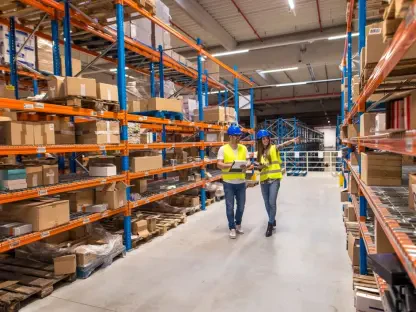Supply chain disruptions have emerged as a significant concern in the context of global commerce, with delays at pivotal points like the Panama and Suez Canals illustrating the vulnerabilities within this network. The challenges are not restricted to commercial entities; federal supply chains face their own complexities, exacerbated by recent global disruptions. In this light, the insights from Melissa Frye and Alex McGuire of GDIT are particularly illuminating, shedding light on how advanced technology and strategic planning can effectively manage these risks.
Strategic Importance of End-to-End Supply Chain Management
Navigating Geopolitical Uncertainties
Melissa Frye, a senior program director at GDIT, emphasizes that managing supply chains end-to-end has become imperative given the unpredictable nature of today’s geopolitical climate. Working with the Department of State Bureau of Diplomatic Security, Frye underscores the importance of pre-procuring and pre-positioning stock to mitigate disruptions caused by unforeseen global events. Her approach to supply chain management aims to ensure that operational integrity is maintained, even in the face of international crises.
Frye’s experience showcases how preparedness is not merely a logistical consideration but a strategic necessity. The COVID-19 pandemic exposed the fragility of many supply chains, prompting organizations to rethink their sourcing and inventory strategies. By having essential items pre-positioned and ready, federal agencies can avoid the pitfalls of sudden shortages and bottlenecks. This proactive stance allows for smoother operations and more effective responses to crises, ultimately enhancing the resilience and reliability of supply chains.
Comprehensive Risk Management
Alex McGuire, Vice President and Chief Supply Chain Officer at GDIT, delves into the complexities of robust supply chain management. He notes that the essential components for this include not only advanced systems and sound processes but also a skilled workforce capable of adapting to changing conditions. McGuire highlights that the Biden administration’s 2021 executive order was crucial in spotlighting supply chain vulnerabilities, resulting in vital initiatives like the White House Council on Supply Chain Resilience and cybersecurity principles tailored for energy systems.
McGuire stresses that successful risk management extends beyond identifying and mitigating cybersecurity threats and counterfeit products. It involves ensuring that each stakeholder within the supply chain understands their specific risks and has the capability to respond effectively. This comprehensive approach helps mitigate a range of potential disruptions, fostering a robust and resilient supply chain infrastructure capable of adapting to ongoing and emerging challenges.
Leveraging Technology and Human Expertise
The Role of Artificial Intelligence and Data Analytics
Quality control remains a cornerstone of effective supply chain management, particularly at GDIT, where rigorous checks are implemented at every step to ensure that customers receive premium products. Frye’s commitment to detail underscores the necessity of maintaining high standards throughout the supply chain. The advent of artificial intelligence (AI) and data analytics has significantly transformed decision-making processes, enabling teams to harness 13 years’ worth of consumer data to enhance efficiencies both internally and for clients.
The integration of AI and data analytics facilitates real-time monitoring and predictive maintenance, allowing for timely interventions that prevent disruptions before they escalate. These technologies also enable the analysis of vast amounts of data to identify patterns and trends that inform strategic decisions. By leveraging these technological advancements, GDIT can optimize its supply chain operations, ensuring that they remain agile and responsive to ever-changing conditions.
Cloud Technologies and Digital Engineering
Cloud technologies and digital engineering further bolster GDIT’s logistics capabilities, aligning seamlessly with the company’s mission to provide reliable and efficient solutions. Cloud-based systems enable the sharing of real-time information across various nodes within the supply chain, enhancing collaboration and coordination. This transparency helps in identifying potential issues early and allows for quicker, more effective responses.
Digital engineering, meanwhile, supports the design and simulation of supply chain processes, enabling GDIT to test different scenarios and identify optimal solutions. These digital tools provide valuable insights into how various factors, such as demand fluctuations or geopolitical changes, might impact the supply chain. By incorporating these technologies into their operations, GDIT ensures that their logistics strategies are informed by the latest advancements, fostering a robust and resilient supply chain infrastructure.
Empowering Personnel for Sustainable Innovation
Upskilling and Process Optimization
While technology plays a crucial role in modern supply chain management, Frye emphasizes that empowering skilled personnel to make informed decisions is equally critical. Upskilling employees and optimizing processes are fundamental to fostering sustainable innovation. By investing in continuous learning and development, GDIT ensures that its workforce is equipped to leverage the latest technological tools and methodologies effectively.
This focus on human expertise complements the technological advancements, creating a symbiotic relationship that enhances overall supply chain performance. Skilled personnel are better able to interpret data, identify potential risks, and implement appropriate solutions, contributing to a more resilient and agile supply chain.
A Multi-Faceted Approach to Risk Management
Supply chain disruptions have become a major concern in global trade, with significant delays at critical junctures like the Panama and Suez Canals highlighting the system’s inherent vulnerabilities. These disruptions aren’t limited to private enterprises; federal supply chains also encounter their own complexities, particularly aggravated by recent global upheavals. Melissa Frye and Alex McGuire from GDIT offer valuable insights in this scenario. They emphasize the crucial role of advanced technology and strategic planning in mitigating these risks. By employing cutting-edge technologies, including predictive analytics and automation, organizations can forecast potential disruptions and develop more resilient strategies. Strategic planning becomes essential, involving meticulous coordination and long-term foresight to anticipate and adapt to unexpected challenges. Their perspective underscores the necessity of evolving supply chain management practices to withstand unpredictable global factors, ensuring smoother operations and minimizing the impact of any potential delays.









